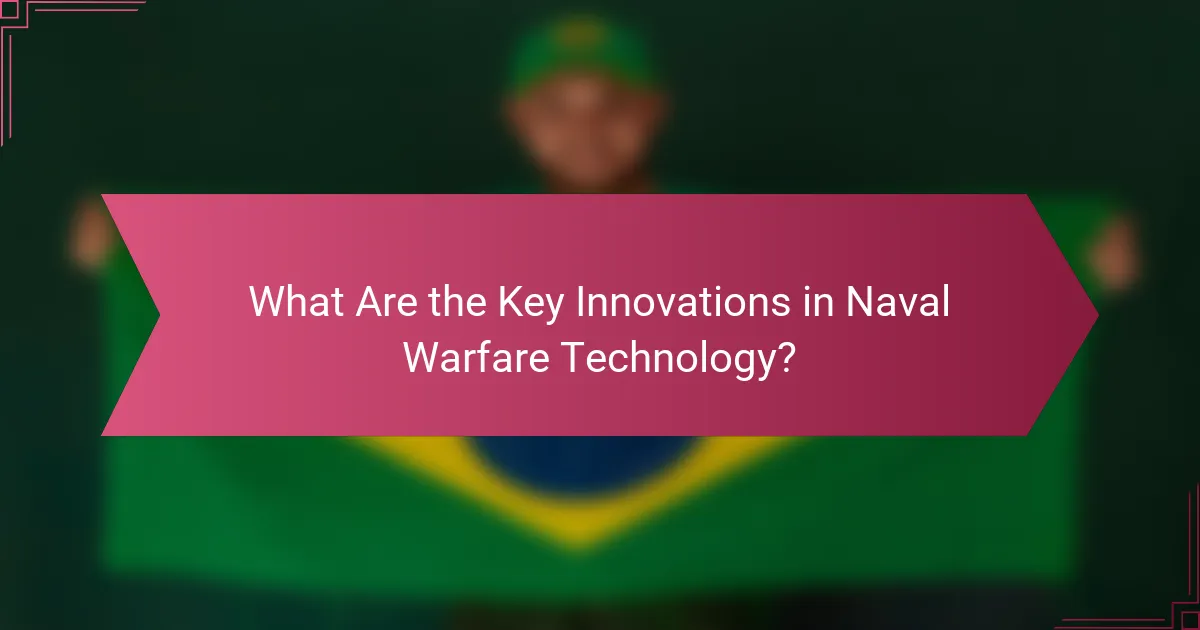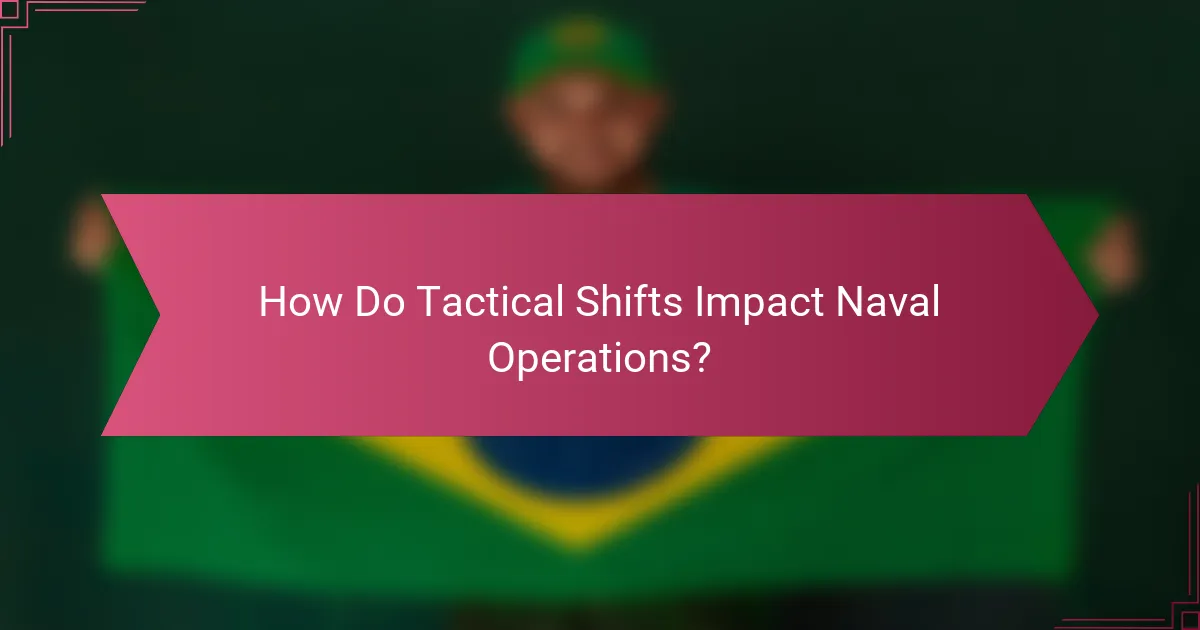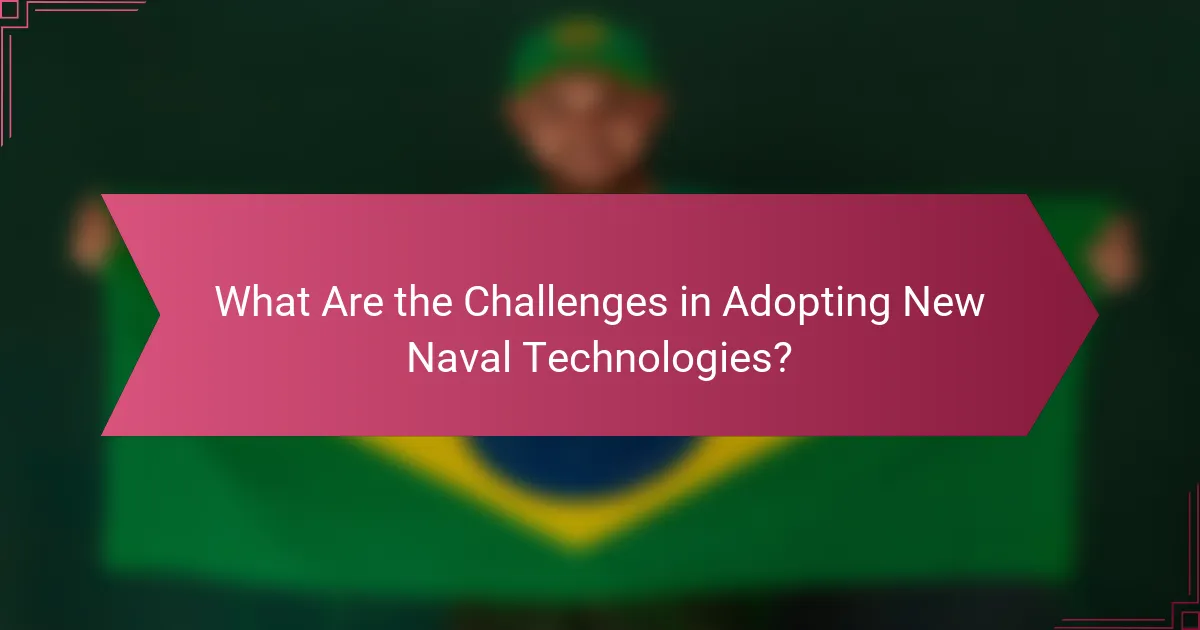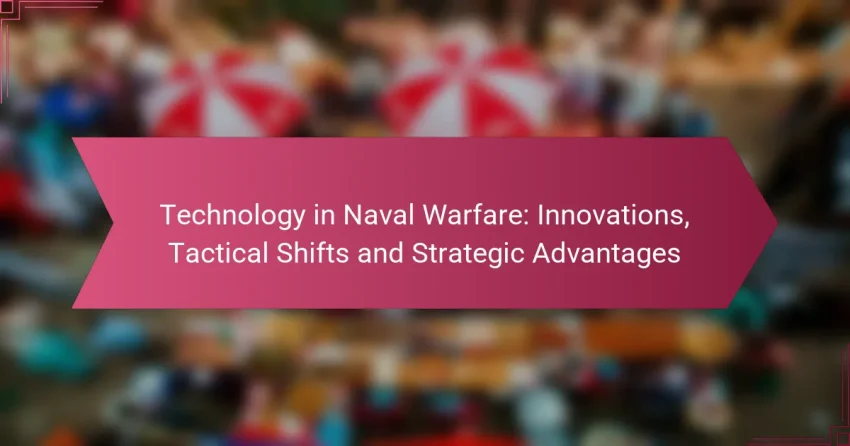In the realm of naval warfare, technological innovations such as unmanned systems, advanced missile capabilities, and artificial intelligence are transforming traditional combat strategies. These advancements not only enhance operational effectiveness and situational awareness but also provide significant strategic advantages in modern conflicts. As navies adapt to these changes, tactical shifts emerge, allowing for more effective engagement and coordination in response to evolving threats.

What Are the Key Innovations in Naval Warfare Technology?
Key innovations in naval warfare technology include advancements in unmanned systems, missile capabilities, cyber warfare, artificial intelligence, and stealth technology. These developments enhance operational effectiveness, improve situational awareness, and provide strategic advantages in modern naval conflicts.
Unmanned Aerial Vehicles (UAVs)
Unmanned Aerial Vehicles (UAVs) are increasingly used in naval operations for reconnaissance, surveillance, and targeted strikes. They can operate in hostile environments without risking crew lives, providing real-time intelligence and extending the operational reach of naval forces.
Naval UAVs can be equipped with various sensors and weapons, allowing them to gather data and engage targets effectively. Examples include the MQ-4C Triton, which offers high-altitude, long-endurance capabilities for maritime surveillance.
Advanced Missile Systems
Advanced missile systems have transformed naval warfare by increasing strike range and precision. Systems such as the Naval Strike Missile (NSM) and the Long Range Anti-Ship Missile (LRASM) enable naval vessels to engage targets from significant distances, enhancing deterrence and combat effectiveness.
These missiles often feature advanced guidance systems, including GPS and terminal homing, which improve accuracy and reduce collateral damage. The integration of such systems into naval fleets allows for more flexible and responsive combat strategies.
Cyber Warfare Capabilities
Cyber warfare capabilities are crucial for modern naval operations, as they protect against and exploit vulnerabilities in enemy systems. Naval forces must be prepared to defend their networks while also being able to disrupt adversary communications and command structures.
Effective cyber operations can involve offensive tactics, such as hacking into enemy systems, and defensive measures to safeguard critical infrastructure. Training personnel in cybersecurity and investing in robust systems are essential for maintaining an edge in this domain.
Artificial Intelligence in Combat
Artificial Intelligence (AI) is increasingly integrated into naval warfare technology, enhancing decision-making and operational efficiency. AI systems can analyze vast amounts of data quickly, providing commanders with actionable insights in real-time.
Applications of AI in naval contexts include threat detection, predictive maintenance for vessels, and autonomous navigation. Leveraging AI can streamline operations and improve response times, making naval forces more agile in dynamic combat scenarios.
Stealth Technology
Stealth technology is vital for modern naval vessels, allowing them to evade detection by enemy radar and sonar systems. This technology reduces the radar cross-section and employs sound-dampening materials, enhancing the survivability of ships in contested environments.
Examples of stealthy naval platforms include the USS Zumwalt, which features a unique hull design and advanced materials to minimize its visibility. Investing in stealth capabilities can provide a significant tactical advantage, enabling surprise attacks and safer operations in hostile waters.

How Do Tactical Shifts Impact Naval Operations?
Tactical shifts significantly alter naval operations by changing how forces engage in combat and coordinate their strategies. These shifts often lead to enhanced effectiveness and adaptability in maritime warfare, enabling navies to respond to evolving threats and opportunities.
Increased Use of Asymmetrical Warfare
Asymmetrical warfare involves unconventional tactics that smaller or less powerful forces use to exploit the vulnerabilities of larger adversaries. This approach has become more prevalent in naval operations, where smaller vessels and submarines can engage in hit-and-run tactics against larger fleets, often utilizing advanced technology to enhance their effectiveness.
Navies must adapt to this shift by incorporating countermeasures such as improved surveillance systems and rapid response capabilities. For example, investing in unmanned systems can help detect and neutralize threats posed by asymmetrical forces.
Enhanced Fleet Coordination
Enhanced fleet coordination is crucial for modern naval operations, allowing multiple vessels to operate together more effectively. This coordination is facilitated by advanced communication systems and integrated command structures that enable real-time information sharing among ships.
Navies can improve coordination through joint exercises and training programs that emphasize interoperability. Utilizing standardized protocols and technologies can also streamline operations, ensuring that fleets can respond swiftly and cohesively to threats.
Integration of Multi-Domain Operations
Multi-domain operations involve the synchronization of naval forces with air, land, cyber, and space capabilities to achieve strategic objectives. This integration allows for a more comprehensive approach to warfare, where naval forces can support and be supported by other military branches.
To effectively implement multi-domain operations, navies should invest in joint training initiatives and develop strategies that leverage the strengths of each domain. For instance, coordinating naval strikes with air support can maximize impact while minimizing risks to personnel and assets.

What Strategic Advantages Do Modern Technologies Provide?
Modern technologies in naval warfare offer significant strategic advantages, including enhanced situational awareness, quicker decision-making, and improved cost efficiency. These innovations transform how naval forces operate, enabling them to respond more effectively to threats and optimize resource allocation.
Improved Situational Awareness
Modern technologies enhance situational awareness by integrating advanced sensors, satellite communications, and data analytics. These tools allow naval forces to gather real-time information about the environment, enemy positions, and potential threats, leading to better-informed tactical decisions. For example, systems like AIS (Automatic Identification System) provide crucial data on vessel movements, helping to prevent collisions and enhance maritime security.
Additionally, the use of unmanned systems, such as drones and underwater vehicles, expands the operational reach and provides critical intelligence without risking personnel. This layered approach to situational awareness enables commanders to visualize the battlefield more comprehensively, improving overall mission effectiveness.
Faster Decision-Making Processes
The integration of modern technologies accelerates decision-making processes in naval operations. Advanced algorithms and artificial intelligence can analyze vast amounts of data quickly, allowing commanders to make timely decisions based on current conditions. This speed is vital in high-stakes scenarios where every second counts, such as during naval engagements or humanitarian missions.
Moreover, real-time communication systems ensure that information flows seamlessly between units, reducing delays in response times. For instance, a naval fleet equipped with secure satellite communications can coordinate maneuvers and share intelligence instantly, enhancing operational synergy and responsiveness.
Cost Efficiency in Operations
Modern technologies contribute to cost efficiency in naval operations by optimizing resource use and reducing operational costs. Automation and advanced analytics can streamline maintenance processes, allowing for predictive maintenance that minimizes downtime and extends the lifespan of equipment. This approach can lead to significant savings over time.
Furthermore, the use of simulation technologies for training purposes reduces the need for costly live exercises. By employing virtual training environments, naval forces can prepare personnel effectively while conserving resources. Investing in these technologies can yield long-term financial benefits, making naval operations more sustainable and effective.

What Are the Challenges in Adopting New Naval Technologies?
Adopting new naval technologies presents several challenges, including financial limitations, the need for specialized training, and difficulties in integrating these innovations with existing systems. Addressing these issues is crucial for effective implementation and maximizing operational efficiency.
Budget Constraints
Budget constraints significantly impact the adoption of new naval technologies. Many naval forces operate under tight budgets, which can limit their ability to invest in advanced systems. Prioritizing expenditures and seeking additional funding sources, such as government grants or partnerships, can help alleviate some financial pressures.
Naval budgets often need to cover not just the initial purchase of technology but also ongoing maintenance and upgrades. A comprehensive cost-benefit analysis can assist in determining the long-term value of new technologies versus their upfront costs.
Training and Skill Gaps
Training and skill gaps pose a major hurdle in effectively utilizing new naval technologies. Personnel must be adequately trained to operate advanced systems, which can require significant time and resources. Developing tailored training programs that focus on specific technologies can help bridge these gaps.
Additionally, ongoing training and simulation exercises are essential to keep personnel updated on the latest advancements. Investing in continuous education ensures that crews are proficient and can adapt to evolving technological landscapes.
Integration with Legacy Systems
Integrating new technologies with legacy systems can be complex and challenging. Many naval vessels still rely on older systems that may not be compatible with modern innovations. A thorough assessment of existing systems is necessary to identify potential integration issues and develop effective solutions.
Using modular technology can facilitate smoother integration, allowing new systems to work alongside older ones without complete overhauls. Establishing clear protocols for integration can help streamline the process and minimize disruptions to operations.

How Do Global Naval Powers Compare in Technology Adoption?
Global naval powers exhibit varying degrees of technology adoption, with the United States and China leading in innovative capabilities. These nations invest heavily in advanced systems, including artificial intelligence, unmanned vessels, and cyber warfare technologies, shaping modern naval strategies.
United States Navy Innovations
The United States Navy is at the forefront of naval technology, focusing on integrating advanced systems to enhance operational effectiveness. Key innovations include the development of the Zumwalt-class destroyers, which feature stealth technology and advanced weaponry, and the use of unmanned systems for reconnaissance and combat.
Additionally, the U.S. Navy is investing in artificial intelligence to improve decision-making processes and operational efficiency. This includes predictive maintenance systems that reduce downtime and enhance fleet readiness, ensuring that naval forces can respond swiftly to emerging threats.
Chinese Naval Advancements
China has rapidly advanced its naval technology, emphasizing the development of aircraft carriers and submarines. The launch of the Type 003 aircraft carrier marks a significant leap in capability, allowing for enhanced power projection and operational range in the Asia-Pacific region.
Moreover, China is focusing on integrating advanced missile systems and cyber capabilities into its naval strategy. The emphasis on anti-access/area denial (A2/AD) systems demonstrates China’s intent to challenge U.S. naval dominance and secure its maritime interests.
